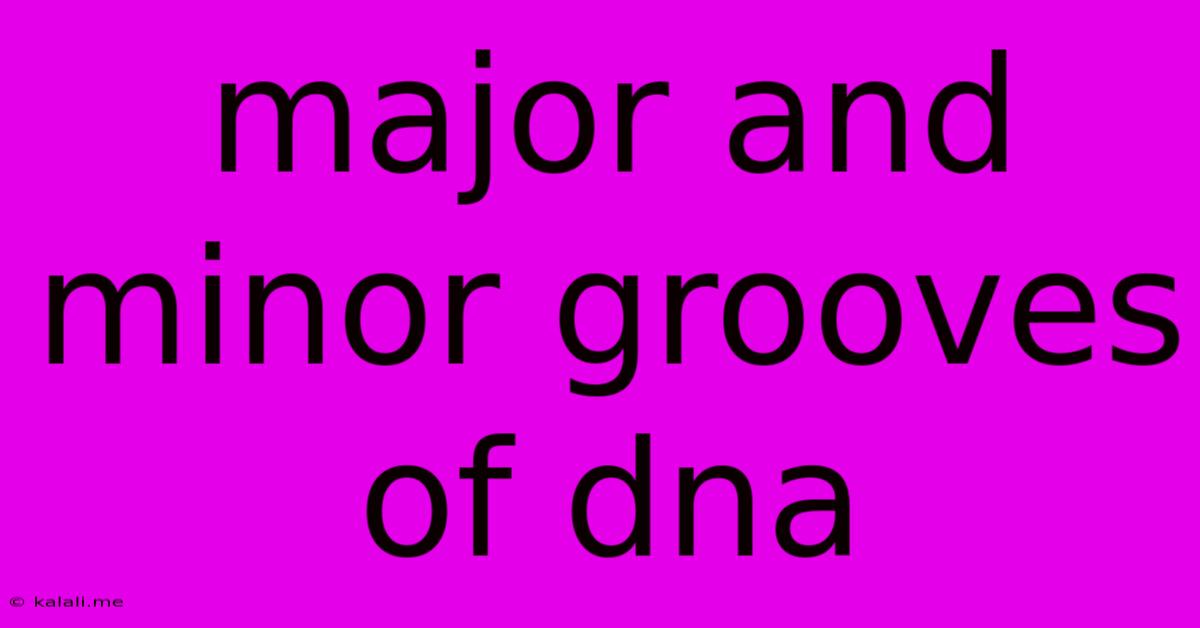Major And Minor Grooves Of Dna
Kalali
May 21, 2025 · 3 min read

Table of Contents
Decoding the Double Helix: Understanding the Major and Minor Grooves of DNA
The DNA double helix, the iconic image representing the building blocks of life, is far more intricate than its simple visual representation suggests. Understanding its structure, particularly the major and minor grooves, is crucial for comprehending how DNA functions and interacts with other molecules within the cell. This article delves into the significance of these grooves, explaining their structure and their crucial roles in various cellular processes, including DNA replication, transcription, and repair.
What are the Major and Minor Grooves?
The DNA double helix isn't a perfectly symmetrical cylinder. Instead, the twisting of the two polynucleotide strands creates two distinct grooves: a major groove and a minor groove. These grooves are formed by the asymmetrical arrangement of the sugar-phosphate backbone and the base pairs. The major groove is wider and deeper than the minor groove, a crucial difference impacting their accessibility to proteins.
The Structure of the Grooves:
The structural differences between the major and minor grooves arise from the geometry of base pairing. While the base pairs themselves are relatively flat, the glycosidic bonds connecting the bases to the deoxyribose sugars are not directly opposite each other. This offset creates the uneven width of the grooves. The major groove exposes more atoms of the base pairs to the surrounding environment than the minor groove. This difference in accessibility is critical for protein-DNA interactions.
The Functional Significance of the Grooves:
The major and minor grooves play a pivotal role in various cellular processes:
1. DNA Binding Proteins: Many proteins, including transcription factors and DNA-repair enzymes, interact specifically with DNA. These proteins often recognize and bind to specific DNA sequences by interacting with the exposed atoms in the major and minor grooves. The major groove generally offers more specific recognition sites due to its wider exposure of base pair atoms.
2. DNA Replication: The grooves play a crucial role during DNA replication. DNA polymerases, responsible for DNA synthesis, utilize the grooves to identify the base pairs and accurately add complementary nucleotides. The interaction with the grooves ensures precise replication fidelity.
3. Transcription: RNA polymerase, the enzyme responsible for transcription (copying DNA into RNA), also interacts with the DNA grooves. The major groove provides crucial information to RNA polymerase about the promoter sequences, initiating the transcription process. Specific transcription factors also bind to the grooves, regulating gene expression.
4. DNA Repair: The grooves are also crucial in DNA repair mechanisms. DNA repair proteins recognize damaged DNA by interacting with the grooves, indicating the location of the damage and initiating the appropriate repair pathway.
The Minor Groove's Role:
While the major groove generally plays a more prominent role in protein binding and recognition, the minor groove also plays important functional roles. Certain proteins specifically recognize and bind to the minor groove, participating in processes like DNA bending and chromatin structure regulation. Its narrower width and less exposed atoms often lead to more non-specific interactions compared to the major groove.
In Conclusion:
The major and minor grooves are not merely structural features of the DNA double helix; they are essential functional elements. Their differing widths and accessibility allow for specific and non-specific protein interactions, playing a vital part in DNA replication, transcription, repair, and overall genome regulation. Understanding the structural and functional significance of the major and minor grooves is key to comprehending the complexity and dynamism of the DNA molecule.
Latest Posts
Latest Posts
-
Bus From Barcelona Airport To Sitges
May 21, 2025
-
Lord Of The Rings And Harry Potter
May 21, 2025
-
Car Battery Will Not Hold A Charge
May 21, 2025
-
Looking Forward To Chatting With You
May 21, 2025
-
Should I Buy A Car With Rust Underneath
May 21, 2025
Related Post
Thank you for visiting our website which covers about Major And Minor Grooves Of Dna . We hope the information provided has been useful to you. Feel free to contact us if you have any questions or need further assistance. See you next time and don't miss to bookmark.